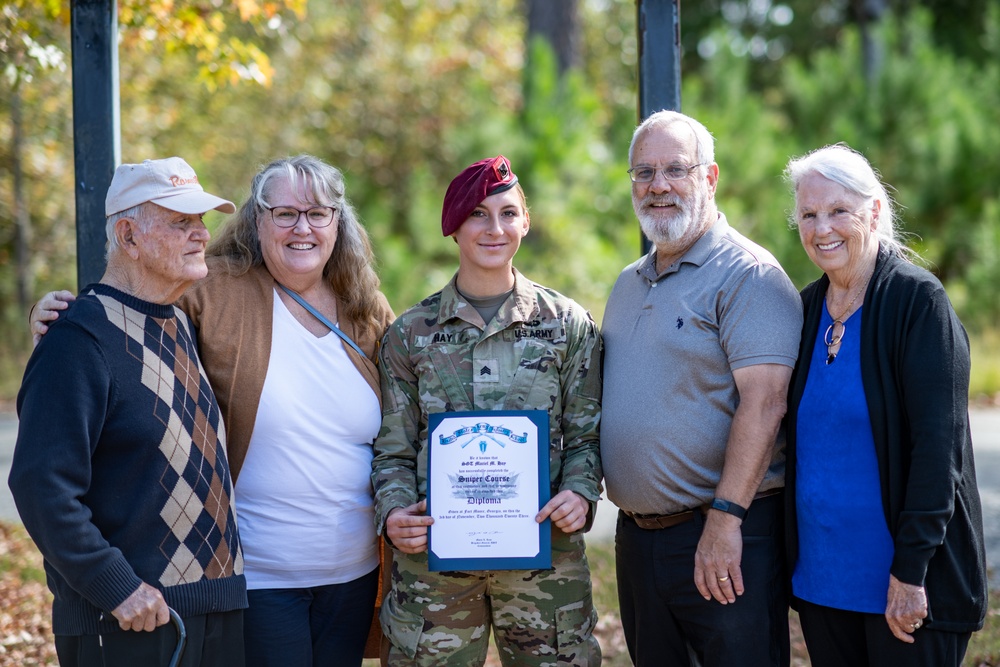During WWII, the Soviet Red Army fielded 2,000 female snipers. Lyudmila Pavlichenko, the deadliest of these snipers, is credited with 309 confirmed kills; other kills of hers were not witnessed by a 3rd party and thus, unconfirmed. Meanwhile, the U.S. Army opened its infantry branch to women in 2015, laying a path for female snipers. On November 5, 2021, an unidentified female of the Montana National Guard graduated from the U.S. Army Sniper Course at Fort Benning, Georgia. Two years later, she is followed by the first female sniper in the active duty component.
On November 3, 2023, Sgt. Maciel Hay, a cavalry scout assigned to 1st Squadron, 91st Cavalry Regiment, 173rd Airborne Brigade, graduated from sniper school. “I grew up shooting, mostly rifles and handguns, on my family’s ranches in Rocklin, California and Medford, Oregon,” Hay said in a 173rd public affairs release. Her nickname was “sniper.” Hay explained, “But the nickname came from the fact that I could find things really fast, similar to how a sniper does target detection.”

Hay learned the basics of shooting from her uncle Cy and marksmanship came naturally to her. While attending Sierra College, she was inspired to join the Army and become a real sniper. “A close friend of mine told me I’d never make it in the Army, and there’s no way I could become a sniper,” Hay recalled. “Needless to say, that person is no longer part of my life. But now that I look back at it, I really do appreciate the motivation.”
In the Army, Hay found instructors and leaders who encouraged her to chase her goal. “Even though I only shot sharpshooter at first, then eventually expert later on in basic training, my drill sergeant encouraged me to pursue the goal of sniper school,” Hay said. Army marksmanship standards require a soldier to hit 23/40 targets to earn a minimum rating of marksman, 30/40 targets for sharpshooter, and 36/40 targets for expert.

After graduating basic training and cavalry scout advanced individual training, Hay was assigned to 1-91 CAV and found more leaders willing to help her reach sniper school. “Sgt. Hay is just an incredible non-commissioned officer [who] comes to work every day with the intention of making not only her team better, but also the entire organization,” Sgt. 1st Class Antwon Jones, her platoon sergeant, said in the press release. “One example that comes to mind is our new Behavioral Health Provider, Capt. Lee. He wasn’t even in-processed with the unit at that point, but he made time on a Saturday to meet with Sgt. Hay for a screening needed for her submission packet.”
Prior to attending sniper school, Hays also had to craft a ghillie suit, a camouflage clothing worn by snipers to blend into their environment. “It took many hours, multiple people and tons of sewing to create an acceptable ghillie suit,” Hays said, highlighting the group effort. The ghillie suit is a vital part of the five-week course which goes beyond marksmanship to include stalking and concealment, observation and intelligence gathering, survival skills and land navigation.

Upon graduation, Hays and her classmates received certification as U.S. Army Snipers. Her family flew to the graduation and saw her in uniform for the first time. “Due to COVID travel restrictions, they weren’t able to make it to my basic training or Advanced Individual Training a few years ago,” Hay said. “Then, I went straight to Germany to join my unit. So it was really nice to see them and I’m grateful for their support.” Hay’s next assignment is to 1st Squadron (Airborne), 40th Cavalry Regiment in Anchorage, Alaska, and her next goal is to become a jumpmaster.


